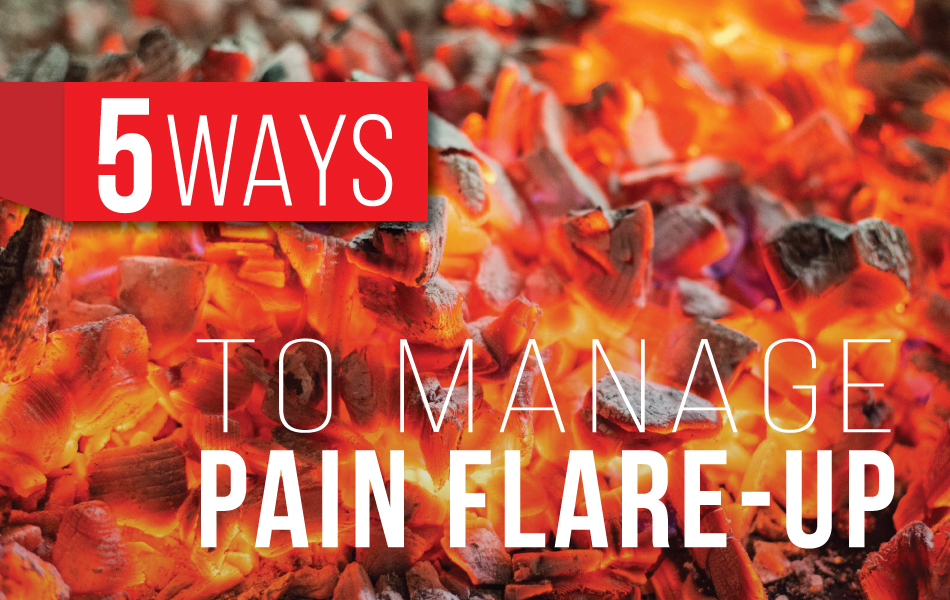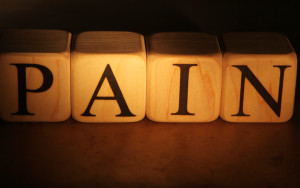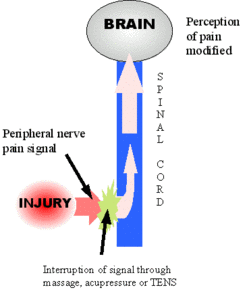Total Therapy Blog

5 Ways to Manage Pain Flare-ups
 This article was written by our Clinical Counsellor, Kate Bilkevitch.
This article was written by our Clinical Counsellor, Kate Bilkevitch.
I enjoy working with individuals of various cultural, socioeconomic and familial backgrounds. Within my clinical practice I have had the opportunity to help clients address a wide variety of concerns, and I am looking forward to broadening my experience even further. I work with individuals around many different concerns including anxiety, depression, trauma, Post Traumatic Stress Disorder (PTSD) and general life struggles.
On a personal note, I enjoy spending time with my wonderful family and I am also learning to play the piano.
So what exactly is pain?
 If you are experiencing pain, you are not alone. Indeed, many of us have seen a doctor for pain‐related complains. For instance, back pain is one of the most common chronic conditions in Canada, with four out of five adults experiencing at least one episode of back pain at some time in their lives. But what exactly is pain? While most of us have felt it, many of us may find it somewhat challenging to define pain. International Association of the Study of Pain provides the following definition of pain: an unpleasant sensory and emotional experience associated with actual or potential tissue damage, or described in terms of such damage. Interestingly, this definition does not mention the degree to which a sensory experience needs to be unpleasant to translate into pain. Moreover, a sensory experience is not even necessary to be present to produce pain! In fact, according to the same source, many people report feeling pain in the absence of actual tissue damage or “any likely pathophysiological cause”. Remarkably, in case of the latter, what people actually experience is indistinguishable from the experience of those people who in fact sustain tissue damage. Pain appears to operate in the same way, whether there is actual physical damage present or not.
If you are experiencing pain, you are not alone. Indeed, many of us have seen a doctor for pain‐related complains. For instance, back pain is one of the most common chronic conditions in Canada, with four out of five adults experiencing at least one episode of back pain at some time in their lives. But what exactly is pain? While most of us have felt it, many of us may find it somewhat challenging to define pain. International Association of the Study of Pain provides the following definition of pain: an unpleasant sensory and emotional experience associated with actual or potential tissue damage, or described in terms of such damage. Interestingly, this definition does not mention the degree to which a sensory experience needs to be unpleasant to translate into pain. Moreover, a sensory experience is not even necessary to be present to produce pain! In fact, according to the same source, many people report feeling pain in the absence of actual tissue damage or “any likely pathophysiological cause”. Remarkably, in case of the latter, what people actually experience is indistinguishable from the experience of those people who in fact sustain tissue damage. Pain appears to operate in the same way, whether there is actual physical damage present or not.
Gate control theory of pain
 The Gate Control Theory postulated by Melzack and Wall in 1965 proposes that there exist “gates” on the bundles of nerve fibres of the spinal cord. These gates can open, thus allowing the pain impulses to the brain or close and cut the pain impulses off. Interestingly, certain stimuli can close the gate to the pain sensation. For instance, recall the last time you bumped your knee. What was your immediate reaction? Most of us would quickly rub the affected area, thereby sending signals to the brain to cancel the sharp pain (which tends to travel at a slower pace). There are certain factors that can open the gates and factors that help closing the gates. For instance, negative emotions, vigilance, attention and boredom tend to open the gates. So if you were to sit and just focus on your pain sensation this would keep the gate open. On the other hand, medications, endorphins and enkephalins, as well as positive emotions, distractions, rest, relaxation and physical activity help closing the gates.
The Gate Control Theory postulated by Melzack and Wall in 1965 proposes that there exist “gates” on the bundles of nerve fibres of the spinal cord. These gates can open, thus allowing the pain impulses to the brain or close and cut the pain impulses off. Interestingly, certain stimuli can close the gate to the pain sensation. For instance, recall the last time you bumped your knee. What was your immediate reaction? Most of us would quickly rub the affected area, thereby sending signals to the brain to cancel the sharp pain (which tends to travel at a slower pace). There are certain factors that can open the gates and factors that help closing the gates. For instance, negative emotions, vigilance, attention and boredom tend to open the gates. So if you were to sit and just focus on your pain sensation this would keep the gate open. On the other hand, medications, endorphins and enkephalins, as well as positive emotions, distractions, rest, relaxation and physical activity help closing the gates.
Managing flare‐ups
So we have this Gate Control Theory – but how can it help me manage my pain flare‐ups? Well, understanding the pain theory can help you see that you do have some control over pain. Certainly you cannot simply wish your pain away! But knowing that we have some control over our experience of pain can help us create a better and perhaps a more efficient plan to manage pain flare‐ups. Ask yourself: how do I manage my pain now? Are my coping strategies effective? Here are some strategies that you may add to your routine pain flare‐up management:
Relaxation
 Relaxation or mediation exercises take the focus off pain. These exercises work best if practiced routinely. Getting in the habit of practicing relaxation or mediation exercises is one of the best things you can do to manage your pain flare‐ups effectively.
Relaxation or mediation exercises take the focus off pain. These exercises work best if practiced routinely. Getting in the habit of practicing relaxation or mediation exercises is one of the best things you can do to manage your pain flare‐ups effectively.
Exercise
- During exercise your body releases endorphins (happy hormones). These feel good neurotransmitters produce a feeling of euphoria and reduce pain. Endorphins are essentially your body’s natural pain killers. Since you have them – use them!
Distraction
- Turn your attention to other important events. Try focusing on an interesting film or family activity.
Anxiety management
- As discussed earlier, negative emotions such as anxiety actually tend to open the gates to pain. If you do experience anxiety try to develop some coping strategies to reduce this unpleasant emotion.
Reducing negative thoughts
- When we talk about reducing negative thoughts, we do not mean “sugarcoating” things. What you would be doing is replacing your negative thoughts with the more realistic ones. This can be very beneficial (more on that in the next article).
Other important options include:
- Having heat/ice handy
- Utilizing massage therapy
- Maintaining social relationships
It is very normal for the pain to have periodic increases and decreases that you may not always be able to predict. But you do have some control over taking comfort measures which will help you reduce the distress associated with pain flare‐ups. The tips noted above can help keep pain more tolerable and manageable. It is also important to remember that most of pain flare‐ups are fairly short in duration.
Sources:
Gun, C. What is Pain? (2002). Retrieved from http://www.istop.org/papers/WhatIsPain.pdf on March 29, 2016.
International Association of the Study of Pain. Retrieved from http://www.iasp‐pain.org/ on March 29, 2016.
Mazzullo, J.M. (1978). The gate control theory of pain. British Medical Journal, 2(6137), 586‐587.
Statistics Canada. Back Pain. Retrieved from http://www.statcan.gc.ca/pub/82‐619m/2006003/4053542‐eng.htm on March 29, 2016.
Stress Management Society. Exercise. http://www.stress.org.uk/exercise.aspx
University of Calgary. Theories of pain perception. http://www.ucalgary.ca/pip369/mod7/tempain/theories








Follow Us!
& Stay Up To Date
BLOG